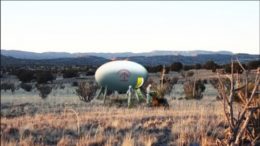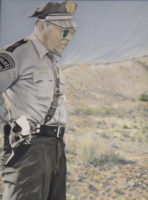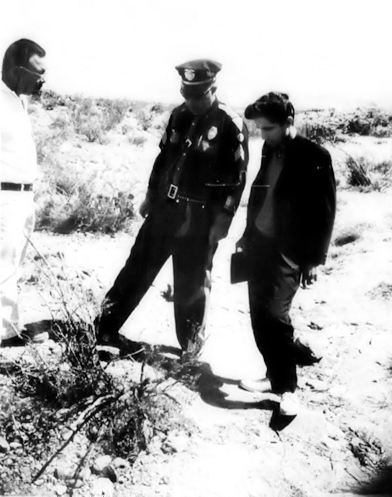By Charles Lear
 The April 24, 1964 sighting of a landed UFO with two beings standing next to it by Socorro, NM Police Sergeant, Lonnie Zamora has been written about extensively and remains a fascinating mystery to this day. What’s particularly interesting about this case is how many people investigated it. Representatives from the Socorro Police, New Mexico State Police the F.B.I. and Army were first on the scene followed by the Lorenzens from the Aerial Phenomena Research Organization, members of the Air Force and J. Allen Hynek as part of Project Blue Book, and Ray Stanford for the National Investigations Committee on Aerial Phenomena. Besides the testimony of Zamora, there was trace evidence to examine, witnesses to a similar craft to interview, and reputed witnesses to the very craft Zamora reported who were searched for but never found. Despite the thoroughness of the inquiries and analyses by so many experienced investigators, no one was able to come up with an agreeable Earthly explanation.
The April 24, 1964 sighting of a landed UFO with two beings standing next to it by Socorro, NM Police Sergeant, Lonnie Zamora has been written about extensively and remains a fascinating mystery to this day. What’s particularly interesting about this case is how many people investigated it. Representatives from the Socorro Police, New Mexico State Police the F.B.I. and Army were first on the scene followed by the Lorenzens from the Aerial Phenomena Research Organization, members of the Air Force and J. Allen Hynek as part of Project Blue Book, and Ray Stanford for the National Investigations Committee on Aerial Phenomena. Besides the testimony of Zamora, there was trace evidence to examine, witnesses to a similar craft to interview, and reputed witnesses to the very craft Zamora reported who were searched for but never found. Despite the thoroughness of the inquiries and analyses by so many experienced investigators, no one was able to come up with an agreeable Earthly explanation.
 According to Zamora’s written report, he was chasing a speeder around 5:45 PM in the southeast section of Socorro when he heard what he described as a roar and saw a flame to the southwest. Just over a nearby hill was a dynamite shack and Zamora was concerned that it might have blown up, so he broke pursuit and went to investigate. As he drove he saw a funnel shaped, narrower at the top, blue and “sort of orange” flame slowly descend behind the hill. He turned onto a dirt road, made it up a hill after three tries, and, after looking around for 15-20 seconds, saw what he thought was a car standing on end in a gully. As he got closer he noted two figures in what looked like white coveralls standing next to the “car” and as he drove quickly towards them to help, one of the figures turned towards him and seemed startled. Zamora was focused on the road and radioed that there had been an accident. When he was close to the site, he went to get out of the car and dropped the mic as he was doing so. He turned to replace it in its holder and, as soon as he turned away from the car to head down into the gully, he heard a roar, and saw flame coming out of the bottom of a white object shaped like an oval on its side, which was rising up slowly. He described the roar as not being like a jet, going from lower pitch to higher pitch and increasing “from loud to very loud.” During this time he noted a red insignia like an arrow under a crescent in the middle of the object. Fearful of an explosion, Zamora ran behind his car, bumping his leg on it and dropping his sun glasses, and kept on running to duck down just over the edge of the hill. He glanced back at the object as he did so and saw that it was completely out of the gully and level with his car. He had intended to keep running down the hill when the roar stopped and was replaced by a whine that went from high to low pitch for about a second. The object then moved away towards the southwest in complete silence, with no flame, in a straight line maintaining a height of 10-15 feet, which Zamora estimated in relation to the dynamite shack, which it had cleared by around 3 feet. According to Zamora the object moved quickly away and then ascended as it took off “across country.” Zamora later recalled seeing legs when the object was landed, that held it about three feet off the ground. Most likely, as he was thinking he was looking at a crashed car at the time, he was unable to put what he was seeing into a proper context. He radioed headquarters and asked the operator, Nep Lopes to look out his window and tell him if he could see what he was looking at. Lopes saw nothing and Zamora gave directions to him and Sergeant Sam Chavez of the State Police who monitored the same frequencies as the Socorro Police.
According to Zamora’s written report, he was chasing a speeder around 5:45 PM in the southeast section of Socorro when he heard what he described as a roar and saw a flame to the southwest. Just over a nearby hill was a dynamite shack and Zamora was concerned that it might have blown up, so he broke pursuit and went to investigate. As he drove he saw a funnel shaped, narrower at the top, blue and “sort of orange” flame slowly descend behind the hill. He turned onto a dirt road, made it up a hill after three tries, and, after looking around for 15-20 seconds, saw what he thought was a car standing on end in a gully. As he got closer he noted two figures in what looked like white coveralls standing next to the “car” and as he drove quickly towards them to help, one of the figures turned towards him and seemed startled. Zamora was focused on the road and radioed that there had been an accident. When he was close to the site, he went to get out of the car and dropped the mic as he was doing so. He turned to replace it in its holder and, as soon as he turned away from the car to head down into the gully, he heard a roar, and saw flame coming out of the bottom of a white object shaped like an oval on its side, which was rising up slowly. He described the roar as not being like a jet, going from lower pitch to higher pitch and increasing “from loud to very loud.” During this time he noted a red insignia like an arrow under a crescent in the middle of the object. Fearful of an explosion, Zamora ran behind his car, bumping his leg on it and dropping his sun glasses, and kept on running to duck down just over the edge of the hill. He glanced back at the object as he did so and saw that it was completely out of the gully and level with his car. He had intended to keep running down the hill when the roar stopped and was replaced by a whine that went from high to low pitch for about a second. The object then moved away towards the southwest in complete silence, with no flame, in a straight line maintaining a height of 10-15 feet, which Zamora estimated in relation to the dynamite shack, which it had cleared by around 3 feet. According to Zamora the object moved quickly away and then ascended as it took off “across country.” Zamora later recalled seeing legs when the object was landed, that held it about three feet off the ground. Most likely, as he was thinking he was looking at a crashed car at the time, he was unable to put what he was seeing into a proper context. He radioed headquarters and asked the operator, Nep Lopes to look out his window and tell him if he could see what he was looking at. Lopes saw nothing and Zamora gave directions to him and Sergeant Sam Chavez of the State Police who monitored the same frequencies as the Socorro Police.
Chavez arrived on the scene approximately three minutes after the object had disappeared from sight. His first observation was that Zamora was pale and seemed shaken and Zamora acknowledged that he was. Chavez and Zamora investigated the landing site and noted there was charred brush that was still smoking, no blast marks, four rectangular indentations with dirt mounded up around them, and four small circular depressions near one of the indentions. The indentations were later interpreted as possibly being caused by landing legs and the circular depressions as marks from a ladder that had been put down twice in order to set it properly. Soon, other officers arrived who also examined the site and would later corroborate Zamora’s and Chavez’ descriptions. Chavez contacted local F.B.I. Special Agent Arthur Byrnes who contacted Stallion Station, White Sands Missile Range and spoke with a Lt. Hicks. Hicks then contacted Army Captain Richard T. Holder. Holder was the acting senior officer at Stallion Station, White Sands Missile Range and was contacted at his home in Socorro. Both men interviewed Zamora and then went to the site, accompanied by military police officers. The men secured the site by flashlight and took measurements and samples. In the midst of the activity, while Zamora was distracted, Chavez took the opportunity to look in his car to see if there were any tools that Zamora could have used to create the indentations and char the brush and he found none. Chavez would later state that his search of Zamora’s car was part of a regular procedure of collecting evidence. The story made national news the next day and Holder was contacted by a colonel who said he was sitting in the Joint Chiefs of Staff war room of the Pentagon and was asked to read his report on the case over the phone, which was equipped with a scrambler.
The first civilian investigators to arrive on the scene were Coral and Jim Lorenzen of the Aerial Phenomena Research Organization. They published an account of their investigation in the May, 1964 edition of The A.P.R.O. Bulletin. They were notified by Arlynn Bruer of the Alamagordo Daily News via telephone at 11 AM on Saturday the 25th. The Lorenzens left their home in Tucson, Arizona at 5 PM, arrived in Socorro at 1 AM, and were at the police station by 9 AM Sunday Morning. They spoke with Chavez and Police Chief Polo Pineda. The officers were very cooperative and drove them to the site in a patrol car where they arrived around 9:45 AM. The Lorenzens took their own measurements and made arrangements to interview Zamora that afternoon at the Dispatcher’s Office. After arriving back at the station, they mentioned their surprise that no one from the Air Force had arrived and were told by Chavez that there were actually two Air Force officers waiting in the hall for him. While Chavez attended to some business, Jim Lorenzen ran into the officers, Sgt. David Moody from Wright Patterson AFB and Maj. William Conner from Kirtland AFB. Jim didn’t mention his last name or that he was from A.P.R.O. and he soon found himself in a candid discussion on the UFO subject with Moody. Moody mentioned a research group in Tucson headed by a Coral Lorenzen, whom he described as “a nut.” At 2 PM, the Lorenzens interviewed Zamora and they described him as being reluctant and that he at first denied seeing the “men” next to the craft and would not discuss the insignia. He later admitted to seeing the “men” but again refused to talk about the insignia and explained that he was told not to. Zamora had already been contacted by members of the press at that time and would soon be at the center of a media onslaught, so his reticence could be understandable. The one thing repeated by all investigators and acquaintances was that Zamora’s reputation as an honest man was impeccable.
On Tuesday, the 28th, Project Blue Book Director, Lt. Col. Hector Quintanilla asked Dr. J. Allen Hynek to go to Socorro and collect more data. According to an account by Kevin Randle in his 2017 book, “Encounter in the Desert”, Hynek arrived that afternoon at Kirtland AFB in Albuquerque and was being driven to Socorro in an Air Force car when they got a flat. Hynek was forced to hitch hike to Socorro and didn’t arrive there until later that evening but was still able to interview Zamora and Chavez. Hynek found that the police officers had developed a dislike for the Air Force by that time and by disassociating himself from the AF personnel he was able to gain their trust and they arranged for a re-enactment at the site the next day.
 A researcher for the National Investigations Committee on Aerial Phenomena, Ray Stanford, had arrived in Socorro after Hynek and had tried in vain to make contact with Zamora there. He went to the police station on Wednesday morning and was told by the dispatcher, Mike Martinez, that Zamora was in the southern section of town. Stanford, convinced he was at the landing site, asked Martinez to make a call on the radio. Chavez answered and said they wanted privacy while Hynek was investigating, but Hynek interrupted and invited Stanford to come out as long as he came alone. When Stanford arrived he and Hynek discussed another case and then Hynek took pictures as Zamora described the object’s entry and exit. Hynek then wanted to take some samples but had nothing to contain them and Stanford offered him the use of some vials he had brought along. Curiosity seekers and souvenir hunters had already taken a lot from the site but Stanford was impressed by a rock pointed out by Zamora in one of the indentations. The rock had scrapes on it and if they were caused by landing gear Zamora reasoned there might be metal fragments left on the rock that could be tested. Hynek didn’t think enough of Zamora’s theory to take it himself, so Stanford returned later and took the rock for his own investigation and had it tested that year at NASA’s Goddard Space Flight Center. Stanford wrote and published a book in 1976, “A Socorro ‘Saucer’ in a Pentagon Pantry” in which he detailed initial results of the tests and alleged there had been intervention by the intelligence community in order to suppress them.
A researcher for the National Investigations Committee on Aerial Phenomena, Ray Stanford, had arrived in Socorro after Hynek and had tried in vain to make contact with Zamora there. He went to the police station on Wednesday morning and was told by the dispatcher, Mike Martinez, that Zamora was in the southern section of town. Stanford, convinced he was at the landing site, asked Martinez to make a call on the radio. Chavez answered and said they wanted privacy while Hynek was investigating, but Hynek interrupted and invited Stanford to come out as long as he came alone. When Stanford arrived he and Hynek discussed another case and then Hynek took pictures as Zamora described the object’s entry and exit. Hynek then wanted to take some samples but had nothing to contain them and Stanford offered him the use of some vials he had brought along. Curiosity seekers and souvenir hunters had already taken a lot from the site but Stanford was impressed by a rock pointed out by Zamora in one of the indentations. The rock had scrapes on it and if they were caused by landing gear Zamora reasoned there might be metal fragments left on the rock that could be tested. Hynek didn’t think enough of Zamora’s theory to take it himself, so Stanford returned later and took the rock for his own investigation and had it tested that year at NASA’s Goddard Space Flight Center. Stanford wrote and published a book in 1976, “A Socorro ‘Saucer’ in a Pentagon Pantry” in which he detailed initial results of the tests and alleged there had been intervention by the intelligence community in order to suppress them.
Hynek was dissatisfied with the Air Force’s handling of the case and he continued his own investigation re-visiting Socorro twice. The case made quite an impression on him and is one of several he came upon that shifted him from skepticism to a belief that there was possibly an otherworldly explanation for some UFOs. He put together an informal group of investigators and scientific consultants shortly after Socorro that would become known as, “The Invisible College.” He then organized a more formal group in 1973 called the Center for UFO Studies.”
The Socorro case is a true classic in UFO history and that it challenged the belief systems of the many people who became involved with it is undeniable. The sheer number of initial investigators ensured that there would be plenty of documents generated and archived. There’s also the advantage of looking at the case from multiple perspectives from hard-core skeptic to true believer.
As an interesting footnote, this blog was written in Magdalena, NM, approximately 20 miles west of Socorro and Lonnie Zamora’s town of birth.
Fascinating.
Shredne VolmerHave you, yourself, been to the Socorro site?
Planning to visit on the 24th. I understand there’s a mural commemorating the sighting but the town doesn’t make a big deal of it. Thanks for reading.
Charles